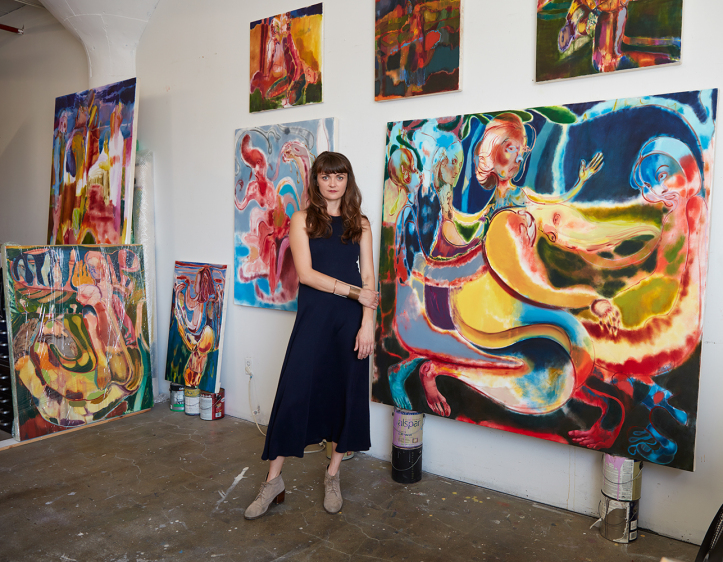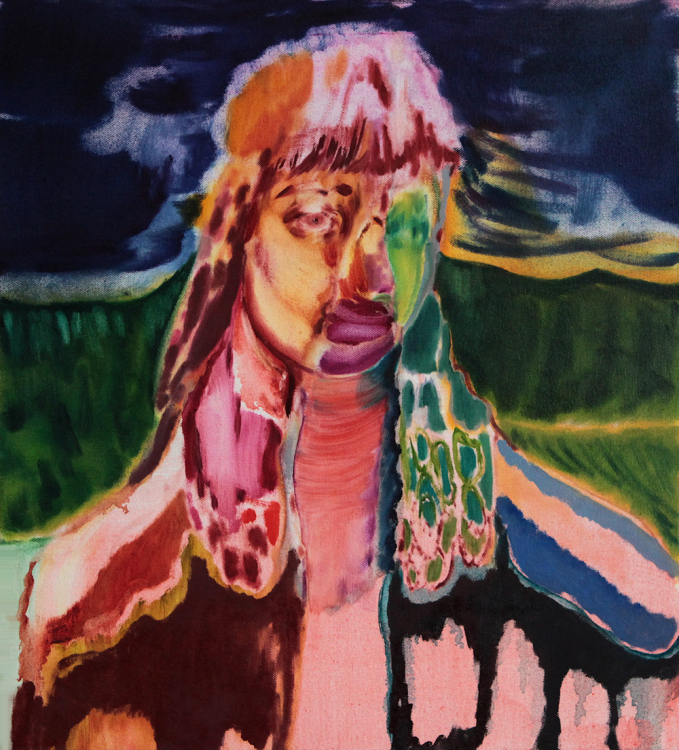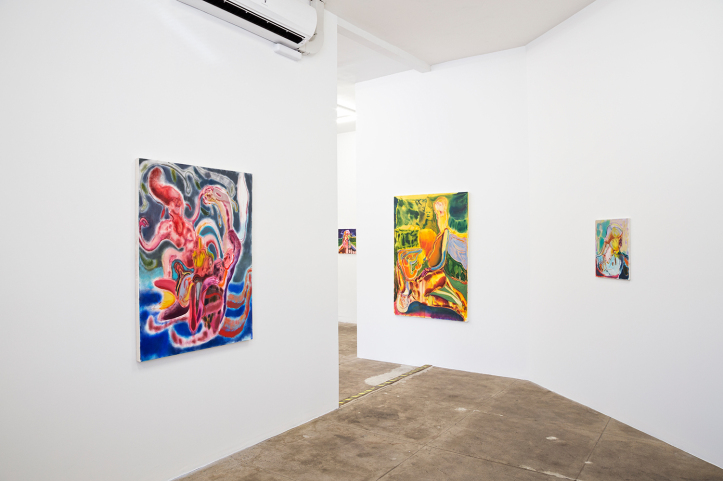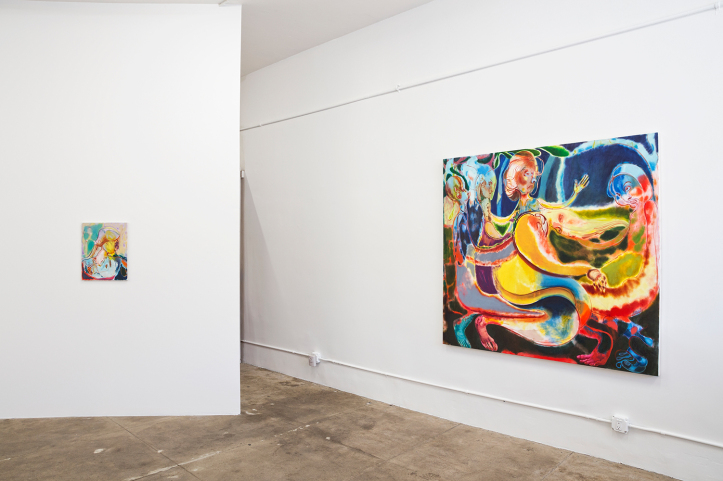November 29, 2016
Download as PDF
View on Art and Cake

Maja Ružnić Residency Studio Image. CES Gallery. Photo Courtesy CES Gallery
This is Part II of a conversation Kristine Schomaker began with Maja Ružnić and Josh Hagler. We took a walk through the arts district of Los Angeles around the corner from their studio to CES Gallery where Maja was exhibiting a solo show “The Wailing Sisters.” We had the pleasure of Megan Gordan, Associate Director of CES Gallery join us for the rest of our conversation.
Kristine Schomaker: This show is called “The Wailing Sisters” and I read that that came out of “The Soil As Witness.” They are very physical paintings, but they’re also deep psychological and philosophical. I know you have your history as a Bosnian refugee. I’m sure that’s always embedded in your work. Is the story from that?
Maja Ružnić: No. I don’t pull directly from that. The paintings are really normal. When I make them I think of myself as an abstract painter and then they end up being figurative. My personal history is always with me; it’s always part of me in what I pay attention to and what I decide to pull into the work. Even though I know that when people learn that about me, they look for clues of that tragedy in my work. I think that’s why I’ve been so into the RB Kitaj manifesto. He’s talking about your past more as something you carry with you. It becomes a filter through which you see the world and I would say that is more related to my process than my personal history.
“The Soil As Witness” is a show I’m working on that’s going to be in San Francisco. I was making that work before I knew about this. “The Wailing Sisters” is the title of that painting. I just kept returning to that painting as my center. When I heard I got the residency, I needed something that felt really finished that was a home base from which the rest of the work could grow out of. I felt like “The Wailing Sisters” were these spiritual beings that gave birth to the other ones. So, that’s how the rest of it was made.
This new sort of rubbing process is closely connected to working on paper, which what I was doing over the last six years. I was working with gouache, watercolor and ink. Before that I was making really thick abstract paintings that were really about scraping. They were more like Josh’s work in the sense that it was more about excavating. I became really interested in staining while working on paper. It gave me a lot of confidence when I went back to canvas, in that I no longer felt like I needed references, because I didn’t for the works on paper.
I really trusted that the marks would be like the chess pieces that would move and would tell me what to do next. So, that’s how they’re composed. Nothing is planned out. I don’t really do sketches. I start with colors that I have my own relationship with. Yellow is very important to me. There are different kinds of yellow, the more acidic and then there’s the more cool, so I tend to start with that. The forms are based on how I’m rubbing. I start ascribing body parts to them or sometimes there are vague things like this area here where you don’t really know if it’s the back of another figure or something else.
I feel that working on paper allowed me to let ambiguous things be. The paintings I’m working on in the studio now are even more like that — less figurative. I’m playing with how much I can let the figure fall apart. They end up being figures that are sharing limbs; they’re sharing a space; they’re supporting the structure that they’re in, but the structure is also supporting and cradling them. I don’t know why that’s interesting to me. I want the situation to reference that it is a painting and that there is a perimeter around it. The kind of halo quality that they all have is something that I discovered with the rubbing. It also somehow feels like working with charcoal. I was really into thinking about it in this way, like using your fingers and smudging.
KS: And what are you using, are you using oil pastel?
MR: No, this is just oil and I use neo megilp as my medium. I like it a little bit more than linseed oil, just because it’s not quite as runny. It’s a bit more of a gel so it does something. I like to play around with things. When my brush is hardly loaded with any paint, I like to have it contaminate another area. I use these very bodily terms when I’m painting. Like one color contaminating another, going into this area in this not really smart way. This is something I was told not to ever do. I think of myself as constantly questioning painting, but also questioning rules. I hope to imbue this political into the language of painting because I don’t want it to feel heavy-handed, whatever the content might be. I really want it to be about paint.
KS: Yes, the formal qualities.

Twitching Eye. Maja Ružnić “Wailing Sisters” exhibition. CES Gallery. Photo Courtesy CES Gallery
At this point in the conversation we are joined by Meghan Gordon, Associate Director of CES Gallery.
Meghan Gordon: I think that’s something that, in person, is so different than looking at your work digitally. You can zoom in and out of areas. The way you were talking about your relationship to fabric and clothing, and your mother; that kind of personal history and the way that your personal history comes out in many different facets in the work. I think it’s really that, the form is saying something to me about the personal history. I’m deriving something. You were talking about staining and you zoom in on these fabrics. I see that you’re struggling to put the things that you’re interested in into the work and also not say too much. That balance of your hand and your brain is becoming excellent. In this body of work especially. In “The Soil As Witness” work there’s a marked difference. The work you were doing before was amazing, but this is so much more complex. And you really feel like all the things you were working on in previous bodies of work are joining together here. And you’re not directing us too much, which I really like too.
Maja Ružnić: Thank you. Yes, Josh and I talk about this a lot, my resistance to naming things. You know what happens when you name something, when you “thing” it, I feel like I’m still naming things. When I finish a painting, when I say “Ah, I don’t really like it that much”, it’s not like I’m not proud of the effort I put into it, it’s just that I didn’t quite get there with the sense of falling apart – that it’s still holding itself together. These two paintings – they’re actually the newest – are different. It’s this fine thing with knowing. It’s really hard to make something that could be unfinished, it gets slightly over the edge to where it no longer feels like an unfinished painting. Even that idea of unfinished and half-cooked or under cooked. That’s interesting. What does that mean? Or the thing is not yet solid, it’s kind of liquid.
MG: I think maybe that’s one formal cue that points me back to my use of conflict. When you end a figure so abruptly, when you can figure out what the two figures are doing together, there’s no thinking involved in that. But, I have to really struggle. It’s a pleasurable struggle. Like a journey to figure out what is happening narratively and then, of course, the form itself.

Maja Ružnić “Wailing Sisters” Installation. CES Gallery. Photo Courtesy CES Gallery
MR: I’m so glad you said that, because it made me remember something. When I went back to Bosnia the first time, I met my cousin who was born under the building my grandpa had built like a bunker. I was thinking about this idea of victim vs. aggressor and all my ideas about who the victim is and who the bad guys are became really blurred. Because this person, my cousin, a victim, is super xenophobic, like so much of the hatred that he was born into. I felt like he was carry this infection of the ethnic conflict that he was unfortunate enough to be born into. He was perpetuating it. So, the same person who is a victim, is also a carrier of the ethnic conflict there. How can I talk about this through paint?
MG: I think that’s important, because as we know, a lot of artists come from a place of privilege, where they haven’t experienced these types of things. I think the way that you’re talking about this topic, it’s a heavy topic, and you’re doing it in a way that is engaging. That cuts to something that’s intrinsic; it feels like this intrinsic idea of an emotion, idea of a conflict, idea of a storytelling. I source things in Chinese painting, Indian painting, I see a lot of different references. They feel very universal in that way.
MR: That’s great! I love all the things you’re seeing.
MG: Something else that’s really powerful in your work, you’re so open when you speak about emotion and the way you think through things. I think that you’re clearly embracing it and that it’s really working. A lot of people are scared to do that because, of course, you’re on display and you’re very vulnerable when you put that out into public space. I think that’s probably another thing that I noticed a huge difference in the previous works. There is much more emotion in these works.
MR: Thank you, I’m so glad you feel that way. I think I got rid of certain things. I want to be very present. I used to do at lot of detail. Doing details is really delicious, in that it’s relaxing, but I decided that it’s not serving the work, because I’m articulating. I’m back to the naming. All my favorite work falls apart and it makes me feel like Rothko and Cecily Brown and all these others. If that’s what I’m moved by then I need to get rid of these things that are really comfortable. So I just got rid of all my small brushes. I just put them away. The work changes if you get rid of certain things that were getting in the way.
KS: I remember thinking about the work that you had at Eastside International. Even though I think they were smaller pieces, maybe on paper?
MR: They were all on paper.
KS: But they seemed more cinematic to me. But maybe that’s the impression that I have now, compared to these.
MR: You know, I changed after that work because I felt that they were too theatrical. I think it was Guston or Rothko, I forget which — I read an interview by one of them and they talked about the difference between theater and emotion. I realized that’s what I didn’t like about my work. It had too much drama. But that’s not feeling. There were a lot of simple formal things that I was doing. They would all have these black, very dark backgrounds, the figures felt more like performers rather than beings.
MG: Definitely, when you think about like, what is the mechanism? What is the stage they’re on? Who’s directing them? Those are questions that are interesting but weren’t serving the paintings. You have avenues now for that in your performance work now. That’s quite interesting that you don’t have to cut that loose, you just shifted to this other zone.

Maja Ružnić “Wailing Sisters” Installation. CES Gallery. Photo Courtesy CES Gallery
MR: Absolutely, and I feel like in the performances there is a place for theater. Actually, the last experience was a bit of a failure and we talked about how much I learned in that I tried to loosen up the parameters of this character I made up. Before the other two, I had very strict rules. There was a very specific way to engage. I thought that was too controlling, so I gave the audience more freedom. But I realized they needed more rules — they wanted more rules. Even though it was a failure, I feel more confident now the next time I do a performance – knowing why something is important.
Actually, another thing. We met and we decided we wanted to start an artist collective. Because another thing we really wanted out of that performance was a conversation. So the three of us decided that can happen along. It doesn’t have to be an either or. We can do these performances, but if we create a platform where we can invite other artists to have conversations that we’re not having. We feel we’re anemic. A lot of us are talking about business things, how to get into a residency, how to do this, how to do that. It’s important stuff, but I crave more.
KS: I took this from your Facebook page. It’s a quote from Rothko. I saw how passionate you were, you even said that you’re obsessed with Rothko. You can see that in the spirituality, the depth. In the quote you had mentioned, “I am not interested in relationships of color or form or anything else. I am interested only in expressing the basic human emotions — tragedy, ecstacy, doom, and so on…The people who weep before my pictures, are having the same religious experience I had when I painted them.” And you had used that.
MR: That’s from this book I’m reading now, it’s called, Pictures and Tears. The first two chapters are about Rothko because there are all these people who have wept in front of his paintings. I really like that because he used religious experience. I liked that he gave himself so much permission to use these very loaded, non-art terms to talk about his relationship to his own practice. That’s what really spoke to me. When I look at his paintings I forget that they’re paintings. They really do feel like portals. I feel things that I don’t even know what they are. I can’t name them. I would hope to have ten percent of that in my work.
KS: One of the reasons I wanted to do this interview and see your studio with Josh, is because I’ve lost a lot of feeling in art today. Especially with conceptual art. You walk into a gallery and there’s a box in the center of the room. Then you have to read the artist statement to know what it is, unless you know the artist. But a lot of times, there is no depth to it. There is some theoretical thing, but where did the depth go? And the emotion in work? And the passion? You and Josh really have that. So it was probably also a personal thing, that I wanted to find that again. That I wanted to see where it is. Because you guys are so passionate, maybe I want some of that to rub off on me!
MR: I like conceptual art. I think of myself as a conceptual artist even though I’m a painter. When I was in school and where I felt like I was making very different work, it was not allowed or encouraged to talk about certain things, even that phrase “religious experience”. So, when I don’t feel moved by the work, it’s not so much that I don’t like the work, it’s that I feel there is need to make that kind of work more. When Rothko said “basic human emotion”, I think it’s more complex saying it today because it’s more scrutinized. What does that even mean? Who’s saying it? These men who are saying these things in the fifties had more permission. But I feel like I need that permission right now. I somehow relate to it more than this very dry academic way of speaking. Even though I love that way of speaking. I kind of feel like I’m both.

Maja Ružnić “Wailing Sisters” Installation. CES Gallery. Photo Courtesy CES Gallery
MG: When you find work that is talking about the political or identity politics, we assume that it has to be photography or video or conceptual sculpture, something like that. What is so powerful about your work is that you are getting at something very political. You can’t put a time, a space, a race, on this, but you’re definitely talking about human conflict and emotion. I think that can be a really good way to address the situation. A lot of work that you would describe as brilliantly conceptual, it’s lacking in the individual subjectivity.
MR: Sometimes!
MG: I’m often finding that there is a lack of that individual’s personality in the work. Clearly you’re paying attention to what’s important to you formally; what’s important to your subject matter. The reason why I think your work is getting better and better so fast is because you’re paying attention to yourself and what you want as opposed to what you think the work should look like. That’s a huge strength. I wish more artists were paying attention to what they felt was important and what they themselves are like.
MR: Thank you for saying that. I think it’s a lot of it. Josh and I look at art together all the time and he’s as hungry for conversation as I am – to the point where we stay up till three and I have to work at six. It’s the bad part about being both artists. We look at shows and we don’t always have the same taste and I’ll end up defending a painting and he’ll do the same. But in that process, I’ll learn what’s important to me. So it changes how I paint when I go back to the studio. I listen to what people say they like about my work. Like the work on paper, everyone loved the detail. There were such horrific things happening in the paintings that no one ever talked about, but I said this is actually great feedback from people because I don’t think they’re connecting to it the way I would like them to.
MG: That’s great. That’s something that really a lot of artists don’t do. That’s something to be proud of. It’s something that we’re excited about here.
MR: Thank you. Well I love to connect. If they are getting something else, it’s back to the drawing board and how can I do this better? I make a lot of work. I have no problem ripping it off, throwing it away. I use to cut up my pieces. I don’t do that anymore. Josh is like, “just roll it up and store it.” I have no reason to, but I’m not precious about it.
I do it sometimes to pieces that I feel are the paintings that move me in a new direction. I have to cannibalize them. So, I did that to the piece that was at Charlie James. It was a big painting, 5 × 6, a pretty good painting, but something bothered me about it. Not in terms of the painting, but it’s existence bothered me. It was so beautiful. I did it. I got a beer afterwards. Then I got a new piece of canvas and stretched it.
KS: Four years ago, I shaved my head for a performance art piece, but I’ve kept it this way. It’s all about body image and feminism. Talking to you, I hadn’t thought about it, but hearing your process. I cut up my work and chop it up and it is part of the process. An important part of the process.
MR: I was an athlete most of my life. Our coach would check in with us. This may seem a little intrusive, but I didn’t feel that way, he would arrange our races based on what our menstrual cycles were because it’s where we were.
MG: Makes sense! That’s your body!
MR: At the age of thirteen I started really paying attention to where I was. When I paint, I need to accumulate a kind of energy. Josh and I are different. He says I look for a stampede and then run with it. But, I jump out of the race. I try to leave a painting half cooked. He’s more of a put-in-the-work kind of painter. His paintings need to be that way. His energy is more like a really big tank that only lets out a little. I work in a huge burst, after which I’m ok with taking three days off and reading. I’ve shared this idea with other painters and they can be so dogmatic about taking time off. I used to feel guilty, but I learned that I would sometimes destroy paintings by just making random marks. So now I paint for three days, then take two days off to read and watch movies. It’s all part of it.
KS: It is! Thank you for being with us today. It was great talking to you and Josh.



